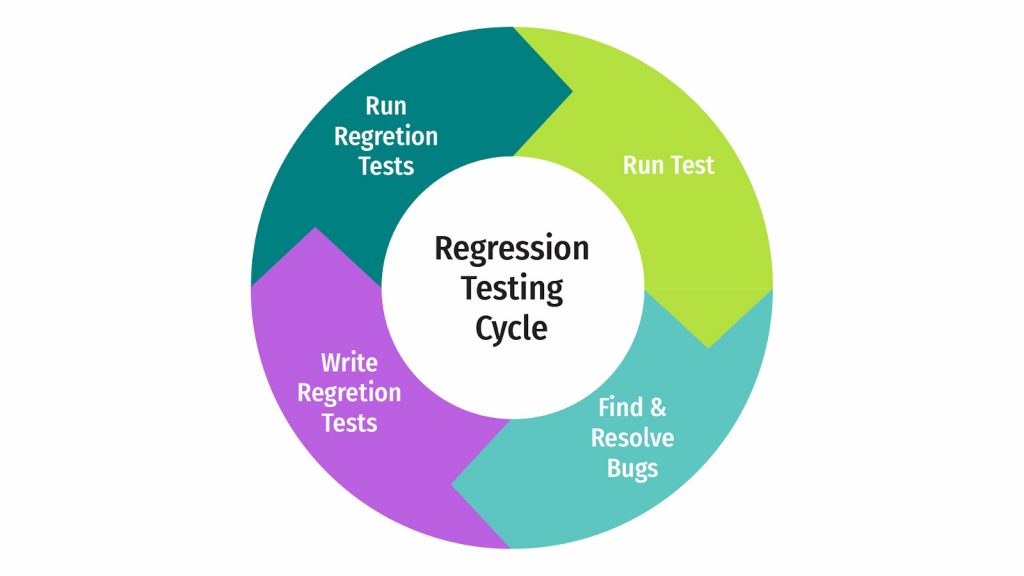Here’s a “shocking” fact: software updates can cause problems.
Business applications aren’t an exception. When companies update their apps to install new features or security tools, they could run into compatibility and other problems.
There’s just no way around it—
New code sometimes affects software stability or performance.
That’s where regression testing comes in. This type of testing can be a blessing because it discovers issues that occur after software updates or changes.
In this post:
- Regression testing definition
- Types of regression testing
- When to conduct regression testing
- Regression testing strategy
Hire regression testing experts with a top rating on Clutch. Get started with a free consultation.
Not here to read about regression testing? These guides might be useful:
- Mobile App Development Process Explained
- App Monetization: How to Start Making Money With Apps
- Offshore Software Development: All Your Questions Answered
What is Regression Testing?
Regression testing is a type of software testing designed to check if an app works as intended after changing and/or updating its code. Since code changes might affect functionality by introducing bugs, regression testing is run to verify if the app works fine.
The regression testing process consists of four basic steps: test writing, running tests, re-running them, and comparing results. Basically, QA teams create original regression tests, run them as controls, and then rerun them to find issues.

Read more about Quality Assurance (QA) teams: Who is a QA engineer? Roles & Responsibilities in Software Teams
Types of Regression Testing
As we know, software regression testing has four essential steps.
But—
The testing process can be performed in different ways. For example, a highly complex application like Uber might require deeper testing than, say, a weight tracker app.
That’s why we have seven types of regression testing. Each type is designed to address certain changes, areas of recurring issues, or bits of code.
Regression testing types:
- Unit regression testing. Designed to check and ensure that individual code bits work as intended.
- Partial regression testing. Conducted to check only the updated part of software along with the connected parts.
- Retest-all regression testing. A time-consuming method that involves re-testing the entire app for potential issues.
- Selective regression testing. Involves selecting the changed parts of software instead of re-checking the entire application.
- Corrective regression testing. Performed for preventive maintenance with test cases used by previous checks on the same code.
- Progressive regression testing. Designed to ensure that the existing features will work on an updated version of the app.
- Complete regression testing. Suitable for testing major changes and updates because it gives the most comprehensive check.
Now that we know the purposes of all regression tests, let’s get clear on when they might be needed.
Besides regression testing, developers also check apps for performance using other methods (functional, security, and structural).
Read more about their role: Types of Software Testing
When To Conduct Regression Testing?
I’ve mentioned some cases when software regression testing is used. Now, let’s go over them one more time to cover everything.
New functionality is added
When developers add a new feature or otherwise update an app, they don’t fully focus on the compatibility with the existing code. Before we blame them, let me say one thing: it’s not strictly their job to check compatibility.
Regression testing is the responsibility of the quality assurance team. They are the people who design tests, run them, and find issues. If testing discovers some issues, then fixing them becomes the priority of developers.
Changes in the existing functionality
Update of features is a step that businesses take to keep their apps competitive and relevant. After all, Google Play Store has over 2.5 million apps, with hundreds or in every category. The same goes for business apps: Google “custom accounting software,” and you’ll find dozens of options.
So, if an app’s features get updated, the QA team employs regression testing. This way, they check if the changes affected the app’s performance in any way.
Integrations with other applications
Companies that use complicated software often use additional apps to enhance functionality. For example, a logistics company can add warehouse management, Salesforce, or other apps to streamline processes.
Regression testing is conducted when integrations with other apps are added to existing software. The purpose is to ensure that everything works even after integrations are implemented.
Regression Testing Strategy
Knowing the reasons for and the types of testing, we can work out an effective regression testing strategy.
Consider these steps to get started.
Step I: Choose a testing type
Here, we simply need to choose an appropriate regression testing type. Will you be focusing on some parts or re-test the entire application? In many situations, particle testing is the right way to go. But you’ll want to give a complete check if the app hasn’t been tested in a while.
Step II: List the changes that have been made
The goal here is to understand the nature of those changes. A common approach is to create a list in a special document that every team member can access. The project manager and the QA regression testing team will be the ones using that doc later.
Step III: Define potentially affected features
Now, proceed to analyze the list of changes and make a list of features that they could have impacted. For example, if an app received a security-related update, you might want to consider user permissions, account privacy settings, etc.
Step IV: Consider adding extra features for testing
As long as we’re testing the app, it makes sense to include “problematic” features. Those are the features that get the most complaints from users, etc. Often, they are also affected by updates because of the proneness to bugs.
Step V: Create individual tests
Next, break down the features into test cases. QA regression testing specialists will create individual checks for them to organize their work. This way, the entire project gets broken down into parts, which makes the overall management easier.
Step VI: Decide on the format of test reports
QA testers will agree on the universal test report for consistency. A good report must contain the description of a problem, test conditions needed for replication, and the expected and actual results. Media such as screenshots and videos are also considered.
Step VII: Start testing
Now, we finally get to actually testing the application. Whether manual or automated, testing runs until the QA team covers all issues and creates bug reports.
Step VIII: Save test cases
Test cases can be reused for extra testing, so you need to save them. That’s why the QA team uses a special tool to create templates for tests to add to future checks.
App developers can earn between $200 to $3,000 even during the first month after launch. See these 21 App Ideas for Startups to know how to join them.
Popular Regression Testing Tools
Many tests in regression testing can be automated, which saves time. Here are some of the most popular tools in the game:
- Selenium
- Testsigma
- TestComplete
- Katalon Studio
- Ranorex Studio
Hire Experts in Regression Testing
IDAP Group is a software development company you can hire to do regression testers for your needs. We are trusted by both startups and big companies (you can check out our portfolio), and have experience testing apps of different complexities.
IDAP can:
- Use any type of regression testing
- Test both websites and applications
- Provide a dedicated team of software testers
But don’t just take my word for it—
Here’s what our client, the CEO of a yacht management company, had to say about working with us:
“We’ve worked with IDAP on software development, and testing across the project… The most direct impact is the satisfaction of our users and how often we get praises for how well our product works!”
You can also read this review in full on Clutch.
Our Clutch profile has more reviews if you’re interested.
But if you want to talk business right away—Drop us a line through this contact form or just call us.
Summary
The purpose of regression testing is to confirm that software works properly after updates. This method helps businesses prevent unexpected surprises, especially in cases when continuous changes are introduced.
We hope this guide was a good introduction to the regression testing process. Now, you know the basics of this testing method, which should be helpful in software projects.



